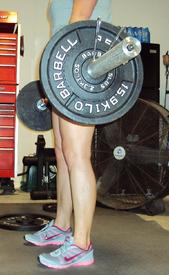Should I be netting my BMR?

Makoce
Posts: 938 Member
So, I switched to my TDEE a few weeks ago.
It gave me 1,600 calories for lightly active
( 30 day shred a day, 15 - 20 minute walks, & the gym 3 days a week or less, that's lightly active right? )
So that's what I've been eating.
But I figure on days I go to the gym, do 30DS, and walk the dog I'm burning around 300+ calories total.
That would net me at about 1,200 - 1,300 calories, when my BMR is around 1,459
But on days when I only do 30DS, Im netting to about 1,400
I know TDEE accounts for exercise taken out, but am I doing this right?
Last night I ate 1,800 calories by accident because I ate my logged exercise, I netted at about 1,483
It gave me 1,600 calories for lightly active
( 30 day shred a day, 15 - 20 minute walks, & the gym 3 days a week or less, that's lightly active right? )
So that's what I've been eating.
But I figure on days I go to the gym, do 30DS, and walk the dog I'm burning around 300+ calories total.
That would net me at about 1,200 - 1,300 calories, when my BMR is around 1,459
But on days when I only do 30DS, Im netting to about 1,400
I know TDEE accounts for exercise taken out, but am I doing this right?
Last night I ate 1,800 calories by accident because I ate my logged exercise, I netted at about 1,483
0
Replies
-
reason im curious is because since i stopped losing water weight, my scale hasnt moved.0
-
anyone?0
-
That seems like a low TDEE unless you are really petite, especially since you said you used lightly active ( which sounds about right or maybe moderately active). Is that with a % off?
You don't eat back exercise calories if you use TDEE, but if you are really hungry on those gym days, have a healthy snack?
I would think you'd want to stay above Bmr.
Keep in mind the exercise calories on mfp can be on the high side of reality!0 -
I'm 5"2', so I guess I am petite.
It's with a 20% deduction.
And oh I know, I just accidentally ate the calories back because I saw the remaining amount and forgot I logged my exercise.
If I was to eat my BMR as a net amount, it would require more than im eating, though0 -
Bump0
-
Here's the deal with the TDEE method...you're going to have days when you're over your BMR and days where you might be slightly under. I don't look at it day to day...I look at it over the course of a week. If I'm netting below my BMR calories for a week I make adjustments...if I'm netting over my BMR for the week things are fine. I have different burns on different days, so I have to look at a longer time frame than day to day.
If you are occasionally below your BMR, it's not a big deal...it's when you consistently net below your BMR for extended periods of time that issues can arise.0 -
I honestly think looking at a caloric range vs one fixed number is the way to go averaged out over the course of a week or month. If you stick to your range of about 1200-1500kcals I think you would find your body responds kinds. Nothing to base this on just my thought for the day.0
-
If you are doing the TDEE - 20% method, then forget logging your exercise and "net calories". Your exercise should be all included in the TDEE. You could eat a little less on days you don't work out or a little more on days you do work out.
I log my exercise as 1 calorie so I can keep track of the days I work out but it doesn't change my net calories on my food log.0 -
Do you think that my exercise that I listed is lightly active? Bear in mind, when I am n0
-
I am reading a book called, The New Rules of Lifting for Women. It is a book on adding resistance training (weight lifting) to your workouts. I found a couple of interesting passages that I want to share with you. This is in reference to how many calories we should be eating in a day. (I am still working on wrapping my head around the concept that I need to eat more calories to lose weight!) The first passage is in response to the common practice of cutting 500 calories from your daily requirement in order to lose one pound a week:
“It takes about 2,800 calories to build a pound of muscle. If you’re slicing 3,500 calories a week from your diet while at the same time engaging in a workout program desiged to increase strength and thus build new muscle tissue, from where will you get those 2,800 calories? My guess is that you’d actually lose muscle if you did these workouts with a 500 calorie a day deficit.”
“If you feel that you must eat below your predicted maintenance level, cut a maximum of 300 calories a day. No matter what, eat more calories on workout days than on nonworkout days. Reassess your strategy after four weeks. If you are chronically tired, having lousy or unproductive workouts, and losing sleep ...then you need to increase your calories until the problems go away. That is, eat more HIGH QUALITY calories from all three macronutrients.”
So I guess my point here is that you need to question your diet strategy. If you are trying to lose weight by severely restricting calories you may end up losing muscle, which will cause that rebound effect when you stop dieting. If all of your exercise is aerobic/cardio, you might be losing muscle and slowing your metabolism as well. The trick is figuring out how to balance your macronutrients so that you are getting enough protein to allow your body to build muscle while at the same time losing weight. My new goal is to do resistance training three times a week. On those days, I increase my protein/carb intake (probably about 250-300 calories). Specifically, I add a protein shake to my diet immediately after my workout. From what I read, it is important to give your body the essential amino acids right away so it can use it to rebuild your challenged muscles. On the other four days, I am going to eat my regular number of calories. In any event, from all that I have read, eating below your BMR is really tough on your metabolism.0 -
Do you think that my exercise that I listed is lightly active? Bear in mind, when I am not doing these things I am sitting doing nothing.0
-
Not likely. Go and use a real TDEE calculator like this one: http://iifym.com/tdee-calculator/Do you think that my exercise that I listed is lightly active? Bear in mind, when I am not doing these things I am sitting doing nothing.0 -
Yes, I would list it as lightly active. You probably still walk to your car, go grocery shopping, do laundry and all the ordinary things in life.0
-
If you use the TDEE method and take exercise under consideration in the calculation, then when you log the exercise in mfp just put as calories 1 because the nutrients would be adjusted as well. But make sure that TDEE-% is above your BMR. If your exercise schedule varies a lot and it is quite unpredictable, then you can do TDEE sedentary -% and log your exercise as full calories burnt and then you eat them.0
-
Yes, I would list it as lightly active. You probably still walk to your car, go grocery shopping, do laundry and all the ordinary things in life.
I walk to my car but that's about it. And that's only 3 times a week :P0 -
If you use the TDEE method and take exercise under consideration in the calculation, then when you log the exercise in mfp just put as calories 1 because the nutrients would be adjusted as well. But make sure that TDEE-% is above your BMR. If your exercise schedule varies a lot and it is quite unpredictable, then you can do TDEE sedentary -% and log your exercise as full calories burnt and then you eat them.
Maybe I should try that. I'm not losing anything. I've been stuck at 159.8 for 3 weeks now0 -
I'm 5"2' 1/2, 160lbs, 20yrs old, and I set the TDEE site to lightly active which gave me 1,600 exactly at -20%If you use the TDEE method and take exercise under consideration in the calculation, then when you log the exercise in mfp just put as calories 1 because the nutrients would be adjusted as well. But make sure that TDEE-% is above your BMR. If your exercise schedule varies a lot and it is quite unpredictable, then you can do TDEE sedentary -% and log your exercise as full calories burnt and then you eat them.
I'd like to lost a pound a week.
Maybe I should try that. I'm not losing anything. I've been stuck at 159.8 for 3 weeks now
If your light activity TDEE-20% is 1600, then you should always eat at 1600, regardless of your exercise because the amount of your exercise was already calculated in your TDEE calculation. So eat around 1600, always stay above BMR, and if any day you over splurge, as long as you kept between 1600-TDEE, you will be fine.0 -
Then why haven't I lost anything in 3 weeks
 0
0 -
Are you measuring all your foods?
How much were you eating before you made this change, and for how long were you doing it? It might be that your body needs a bit more time to adjust to the change.0 -
Do you think that my exercise that I listed is lightly active? Bear in mind, when I am not doing these things I am sitting doing nothing.
I used Fat 2 Fit Radio's calculators, and I settled my calories between light and moderate to give myself a cushion either way (I lift heavy 3x weekly and do light cardio on off days, with 1 rest day). I'm probably close to moderate, but that way if I go over with eating, it's fine. If I stick to it I'm still only at a 100-200 kcal deficit. I have the whole thing printed out and stuck on my fridge, and I set MFP to those calories, with 40% carbs, 30% protein and 30% fat.
If I find in a month that it's not working because I've set myself too high or too low, I will make adjustments. But I do think a cushion is important because you're not going to eat the same every day, you're not going to move the same every day, and there's going to be special occasions and such where you're going to eat twice what you should, and that way you're covered. Look at the long term and use patience.
I was getting way too involved logging every single exercise and trying to figure out how much that burned. It's much easier for me to pick a number and just log what I eat. Either way, I'm eating healthier and about as much as I should be eating, I'm moving in some way every single day, and it's a vast improvement from where I was 3 months ago.
Don't get too hung up on the details and keep the big picture in mind.
I found Fat2Fit's method of "eat like you're at goal weight" very fascinating and thought "ok why not? makes sense" so that's what I'm doing. So that when I do hit my goal weight, I can just keep going and don't have to change anything and it'll definitely be a lifestyle for me then, so that's win/win in my book because that won't put me in danger of having to make major adjustments yet again and risk falling off the wagon and the weight coming back (again).
Edit: Here's the link: http://www.fat2fitradio.com/tools/0 -
Go to this website - its awesome, it calculates everything for you and it adjusts it based on the percentage you want to cut off your TDEE - it tells you your BMR, TDEE and the calories you should be eating. http://scoobysworkshop.com/calorie-calculator/0
-
( 30 day shred a day, 15 - 20 minute walks, & the gym 3 days a week or less, that's lightly active right? )
Nope, that is not lightly active. Moderate at the very least. What part of the 30 Day Shred feels light to you? lol
Lightly active is doing something gentle like walking or a "light" workout at the gym no more than 3 days a week. If you are doing some kind of exercise daily, you don't fit the "lightly active" category.0 -
Are you measuring all your foods?
How much were you eating before you made this change, and for how long were you doing it? It might be that your body needs a bit more time to adjust to the change.
Yes. With measuring cups and a non-food scale for the most part. Some time I eyeball but add a bit extra to over estimate. Before I started doing TDEE I was a binge eater. So I'm sure a lot. I never logged anything.0 -
Then why haven't I lost anything in 3 weeks

1) you're putting too much thought into it
2) if you haven't switched up your exercise, do that. your body is smart, it figures things out quick and tries to hold onto what it has.0 -
Perhaps 20% deficit is too steep? You could try TDEE-10% for a couple weeks and see how that goes. Good luck!0
-
If you are doing the TDEE - 20% method, then forget logging your exercise and "net calories". Your exercise should be all included in the TDEE. You could eat a little less on days you don't work out or a little more on days you do work out.
I log my exercise as 1 calorie so I can keep track of the days I work out but it doesn't change my net calories on my food log.
Yup0 -
Then why haven't I lost anything in 3 weeks

Are you measuring yourself instead of relying on the scale? Are your clothes feeling looser? The scale is a b*tch, plain and simple.0 -
I know TDEE accounts for exercise taken out, but am I doing this right?
Someone else can correct me if I'm wrong, but I think the TTDE does *not* account for exercise. On the Fitbit site, I was asked to classify my activity level so that it could calculate my TDEE, and lightly active was compared to having a desk job, and moderately active was having a job on your feet like a cashier or waitress, and very active was having a job like being a construction worker. I believe that TDEE only accounts for your daily activity of just living your normal life. But that you need to ADD any exercise on top of that by recording it in MFP so that it can adjust for those days when you are more active because of exercise.0 -
So, I switched to my TDEE a few weeks ago.
It gave me 1,600 calories for lightly active
( 30 day shred a day, 15 - 20 minute walks, & the gym 3 days a week or less, that's lightly active right? )
This is more activity than I do in an entire year. Not exactly "lightly active."0 -
Because you are not calculating it correctly as you put your calories at mfp at 1480, which is close to your BMR, and then you have been trying to eat back your calories. Another problem is that you eyeball your food. You will be amazed how much we underestimate when we eyeball. I was doing it with peanut butter and measuring it as tb but when I measured the weight I was surprised how much more I was eating. You need to eat at 1600, -+30, not between 1400-1500. Plus, you are under a stressful situation which also plays a role. Try to sleep a full night's sleep and relax. I gained a lot of weight due to a stressful situation and now that I am trying to take back my life, things have started to improve, one day at a time.0
This discussion has been closed.
Categories
- All Categories
- 1.4M Health, Wellness and Goals
- 398.1K Introduce Yourself
- 44.7K Getting Started
- 261K Health and Weight Loss
- 176.4K Food and Nutrition
- 47.7K Recipes
- 233K Fitness and Exercise
- 462 Sleep, Mindfulness and Overall Wellness
- 6.5K Goal: Maintaining Weight
- 8.7K Goal: Gaining Weight and Body Building
- 153.5K Motivation and Support
- 8.4K Challenges
- 1.4K Debate Club
- 96.5K Chit-Chat
- 2.6K Fun and Games
- 4.8K MyFitnessPal Information
- 18 News and Announcements
- 21 MyFitnessPal Academy
- 1.5K Feature Suggestions and Ideas
- 3.2K MyFitnessPal Tech Support Questions














